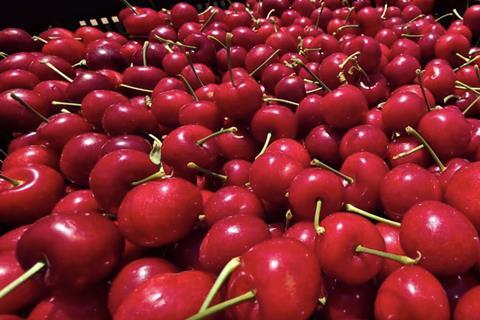Tru-Cape growers in the Ceres region are forecasting a 5-7 per cent increase in cherry production this season, with fruit quality described as ‘excellent’ following near-perfect spring growing conditions that combined ideal rainfall timing with warm, sunny weather during bloom

Tru-Cape growers in Ceres are forecasting an increase in cherry production of 5-7 per cent this year with fruit quality “excellent”, following what has been described as “near-perfect growing conditions” in the Spring.
According to Calla du Toit, Tru-Cape’s procurement director, the season’s crop stems from an ideal combination of rainfall and sunshine.
“The growing conditions have been among the best we’ve ever experienced,” said Du Toit.
“We had good rain before flowering, and then warm, sunny weather during bloom – perfect for cherries,” he confirmed.
”That meant excellent pollination and strong fruit set across the board.”
The warmer spring has also boosted natural sugar levels, promising sweet and juicy cherries, the group noted, with early sugar readings already exceeding 25 Brix, an indication of outstanding eating quality.
“We’re really optimistic about this year’s crop,” Du Toit continued. “The cherries are tasting fantastic. Everything points to a season of exceptional quality.”
Promising harvest
Deon Malherbe, one of Tru-Cape’s cherry producers from Eselfontein farm near Ceres, said the region is on track for its largest cherry harvest to date.
“Alongside strong yields from established orchards, many young blocks are bearing fruit for the first time this season,” he explained.
The 2025 harvest started about seven to ten days earlier than last year, said Nico Verhoef of Witzenberg Properties, one of Tru-Cape’s leading cherry producers in the region.
This earlier start offers Tru-Cape a longer marketing window leading up to Christmas – the peak demand period for cherries.
“Cherries are much higher on consumers’ shopping lists in the run-up to Christmas than afterward,” Du Toit commented. “The earlier season gives us an extra week of sales, which is highly beneficial.”
Verhoef described the start of cherry season as both exciting and nerve-racking.
“The cherry season always brings a mix of excitement and nervous energy,” he said.
“Conditions can change quickly, but so far, we’re in a great position. The trees are loaded, and we’re watching fruit size closely.”
Investing in cooling and quality
To preserve fruit quality and extend shelf-life, Witzenberg Properties has made further investments in cooling infrastructure this year, focusing on faster pre-cooling and cold-chain precision.
“We’ve upgraded our hydro-cooling system to bring fruit temperatures down as quickly as possible after picking,” Verhoef outlined.
“We use smaller trucks to move cherries more frequently from orchard to packhouse. The faster we cool the fruit, the longer it lasts – and we believe this will make a real difference this season.”
With loadshedding now a far smaller risk than in recent years, producers can focus fully on maintaining optimal temperatures throughout the cold chain, Tru-Cape said.
Expanding markets and managing challenges
Tru-Cape said that while its cherries will continue to have a strong local presence – including under the new ’My Cherry’ brand – the company is also expanding into new export markets amid growing international interest.
“While most of our cherries will still be sold locally, a significant share will be shipped to Europe and the UK this year,” said Du Toit.
Exports mainly take place via airfreight to reach markets ahead of Chilean supply, but Tru-Cape is also trialling shared freight shipments to make exports more efficient, Verhoef pointed out.
The group predicts that a highlight of the season will be the upcoming visit from a Chinese trade delegation to inspect local cherry orchards and packhouses, seen as a key step toward securing market access to China.
“There are significant opportunities in China,” said Du Toit. “South Africa has a two- to three-week advantage before Chilean cherries enter the market.
”That short window could be extremely valuable for our industry.”
Domestically, Tru-Cape is aiming to make cherries more accessible for South African consumers.
“We want people to enjoy cherries more regularly, not just as a luxury treat,” said Verhoef, who adds that that global size standards are shifting.
“International buyers increasingly prefer cherries 24mm and larger,” he confirmed. ”In the past, 22mm was fine, but now we’re adapting our orchards and thinning practices to meet that demand.”
To meet evolving expectations, Tru-Cape producers are testing new cultivars and improved rootstock combinations designed to deliver larger, more uniform fruit.
Sustainability and community spirit
Tru-Cape said that it is, along with its growers, continuing to prioritise sustainability in both farming and packaging.
The company is introducing eco-friendly packaging made partly from recycled paper, reducing plastic use and supporting a more circular economy.
Growers are also encouraged to plant fynbos – South Africa’s uniquely rich and diverse native vegetation – around orchards to promote biodiversity and attract pollinators essential for fruit production.
Ceres remains the heart of South Africa’s cherry industry, it said, boasting the largest area under cherry cultivation in the country.
Local enthusiasm is running high as the community prepares for the annual Ceres Cherry Festival, taking place during the first weekend of December.
“There’s a real buzz in town,” Verhoef added. “Everyone in Ceres – from growers to marketers – is coming together to celebrate and promote cherries this season.”



